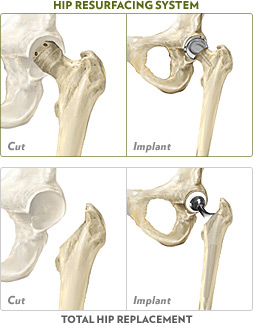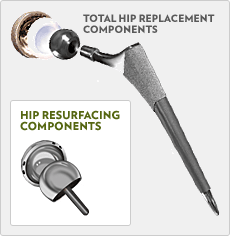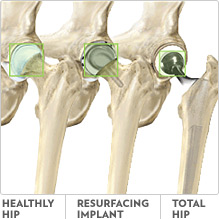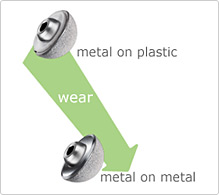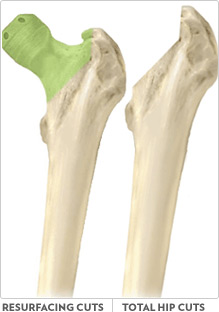Hip resurfacing is intended for young, active adults who are under 60 years of age and in need of a hip replacement. Adults over 60 who are living non-sedentary lifestyles may also be considered for this procedure. However, this can only be further determined by a review of your bone quality.
There are certain causes of hip arthritis that result in extreme deformity of either the head of the femur or the acetabulum (hip socket). These cases are usually not candidates for hip resurfacing.
Contact us to determine if hip resurfacing is the right option for you.
Before deciding on hip resurfacing, your physician may try several non-surgical, conservative measures to relieve the pain and inflammation in your hip.
Lifestyle Modification
The first alternative to hip replacement involves such lifestyle modification measures as weight loss, avoiding activities involving long periods of standing or walking, and the use of a cane to decrease the stress on the painful hip.
Exercise and Physical Therapy
Exercise and physical therapy may be prescribed to improve the strength and flexibility of your hip and other lower extremity muscles. Your exercise program may include riding a stationary bike, light weight training and flexibility exercises. An aquatic therapy program is especially effective for the treatment of arthritis since it allows mild resistance while removing weight bearing stresses. For an appropriate exercise program, contact an experienced physical therapist.
Anti-inflammatory Medications
Arthritis pain is primarily caused by inflammation in the hip joint. Reducing the inflammation of the tissue in the hip can provide temporary relief from pain and may delay surgery.
Non-Steroidal Anti-Inflammatory Drugs (NSAIDs) may be prescribed to decrease the inflammation associated with arthritis. A new classification of NSAIDs, called Cox-2 inhibitors, are often very effective in decreasing pain.
In a small number of cases, the doctor may prescribe corticosteroids, such as prednisone or cortisone, if NSAIDs are not effective. However, due to the higher rate of side effects associated with corticosteriods, a physician must closely monitor their use.
Glucosamine/Chondroitin
Two dietary supplements, Glucosamine and Chondroitin (commonly available in a combined tablet), may decrease the symptoms of hip arthritis. Glucosamine and Chondroitin sulfate are both naturally occurring molecules, and issues associated with both remain under active research. However, it appears that many people taking these nutrition supplements on a regular basis note a decrease in their arthritis symptoms.

